计算机图像处理作业
- 格式:doc
- 大小:1.97 MB
- 文档页数:12
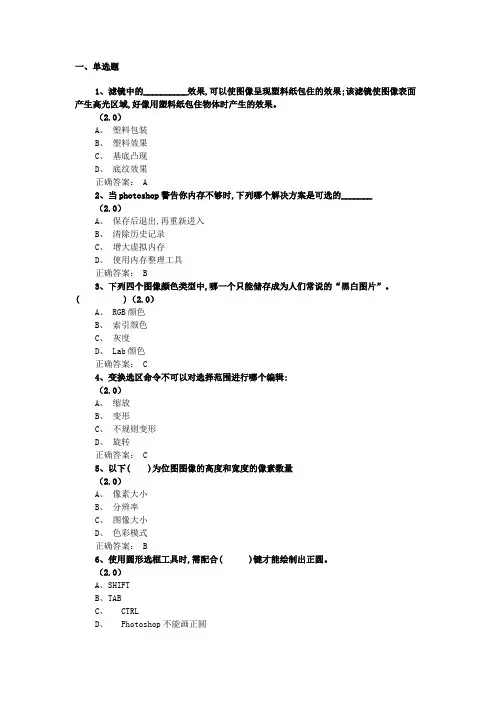
一、单选题1、滤镜中的__________效果,可以使图像呈现塑料纸包住的效果;该滤镜使图像表面产生高光区域,好像用塑料纸包住物体时产生的效果。
(2.0)A、塑料包装B、塑料效果C、基底凸现D、底纹效果正确答案: A2、当photoshop警告你内存不够时,下列哪个解决方案是可选的_______(2.0)A、保存后退出,再重新进入B、清除历史记录C、增大虚拟内存D、使用内存整理工具正确答案: B3、下列四个图像颜色类型中,哪一个只能储存成为人们常说的“黑白图片”。
( )(2.0)A、 RGB颜色B、索引颜色C、灰度D、 Lab颜色正确答案: C4、变换选区命令不可以对选择范围进行哪个编辑:(2.0)A、缩放B、变形C、不规则变形D、旋转正确答案: C5、以下( )为位图图像的高度和宽度的像素数量(2.0)A、像素大小B、分辨率C、图像大小D、色彩模式正确答案: B6、使用圆形选框工具时,需配合( )键才能绘制出正圆。
(2.0)A、SHIFTB、TABC、CTRLD、Photoshop不能画正圆正确答案: A7、在套索工具中不包含下列哪种套索类型:____________(2.0)A、自由套索工具B、矩形套索工具C、多边形套索工具D、磁性套索工具正确答案: B8、下列不支持无损压缩的文件格式是( )。
(2.0)A、PNGB、JPEGC、TIFFD、 PSD正确答案: A9、如果画面颜色偏黄,可以通过下列哪个通道矫正色偏?(2.0)A、红色通道B、蓝色通道C、绿色通道D、复合通道正确答案: B10、下列哪个是Photoshop图像最基本的组成单元:(2.0)A、节点B、色彩空间C、像素D、路径正确答案: D11、如果扫描的图像不够清晰,可用下列哪些滤镜弥补:(2.0)A、噪音B、风格化C、锐化D、扭曲正确答案: C12、当使用绘图工具时,想暂时切换到吸管工具,应该( )(2.0)A、按住Shift键B、按住Alt键C、按住Ctrl键D、按住Command+Alt键正确答案: B13、下列可以使图像产生立体效果的滤镜是:(2.0)A、风B、等高线C、浮雕效果D、照亮边缘正确答案: C14、打开一张CMYK颜色的JPEG格式图像文件,在“通道”调板中,共有( )层通道。
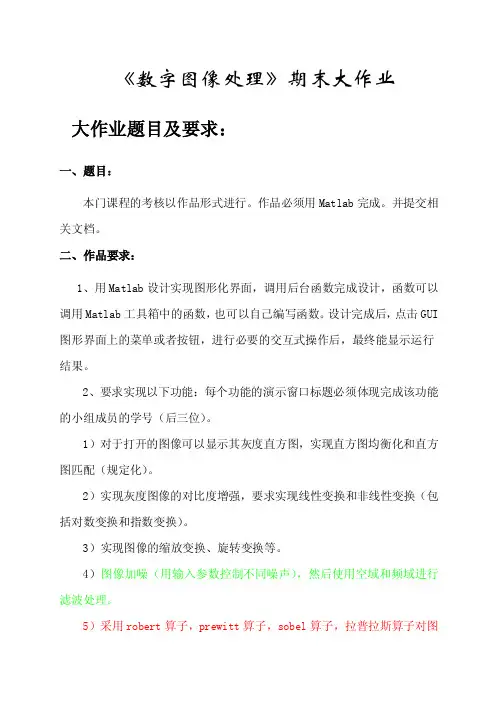
《数字图像处理》期末大作业大作业题目及要求:一、题目:本门课程的考核以作品形式进行。
作品必须用Matlab完成。
并提交相关文档。
二、作品要求:1、用Matlab设计实现图形化界面,调用后台函数完成设计,函数可以调用Matlab工具箱中的函数,也可以自己编写函数。
设计完成后,点击GUI 图形界面上的菜单或者按钮,进行必要的交互式操作后,最终能显示运行结果。
2、要求实现以下功能:每个功能的演示窗口标题必须体现完成该功能的小组成员的学号(后三位)。
1)对于打开的图像可以显示其灰度直方图,实现直方图均衡化和直方图匹配(规定化)。
2)实现灰度图像的对比度增强,要求实现线性变换和非线性变换(包括对数变换和指数变换)。
3)实现图像的缩放变换、旋转变换等。
4)图像加噪(用输入参数控制不同噪声),然后使用空域和频域进行滤波处理。
5)采用robert算子,prewitt算子,sobel算子,拉普拉斯算子对图像进行边缘提取。
6)读入两幅图像,一幅为背景图像,一幅为含有目标的图像,应用所学的知识提取出目标。
3、认真完成期末大作业报告的撰写,对各个算法的原理和实验结果务必进行仔细分析讨论。
报告采用A4纸打印并装订成册。
附录:报告模板《数字图像处理》期末大作业班级:小组编号:组长:小组成员:浙江万里学院计算机与信息学院2013年12月目录(自动生成)1 绘制灰度直方图,实现直方图均衡化和直方图匹配(规定化)1.1 算法原理1.2 算法设计1.3 实验结果及对比分析图1 ××××××图2 ××××××分析***********************************************2 灰度图像的对比度增强2.1 算法原理2.2 算法设计2.3 实验结果及分析3 图形的几何变换3.1 算法原理3.2 算法设计3.3 实验结果及分析4 图像加噪(用输入参数控制不同噪声),然后使用空域和频域进行滤波处理4.1 算法原理4.2 算法设计4.3 实验结果及分析5 采用robert,prewitt,sobel,拉普拉斯算子对图像进行边缘提取5.1 算法原理5.2 算法设计5.3 实验结果及分析6 读入两幅图像,一幅为背景图像,一幅为含有目标的图像,应用所学的知识提取出目标6.1 算法原理6.2 算法设计6.3 实验结果及分析7 小结(感受和体会)(英文版)Two regulations promulgated for implementation is in the party in power for a long time and the rule of law conditions, the implementation of comprehensive strictly strategic plan, implementation in accordance with the rules and discipline to manage the party, strengthen inner-party supervision of major initiatives. The two regulations supporting each other, the < code > adhere to a positive advocate, focusing on morality is of Party members and Party leading cadres can see, enough to get a high standard; < rule > around the party discipline, disciplinary ruler requirements, listed as "negative list, focusing on vertical gauge, draw the party organizations and Party members do not touch the" bottom line ". Here, the main from four square face two party rules of interpretation: the first part introduces two party Revised regulations the necessity and the revision process; the second part is the interpretation of the two fundamental principles of the revision of laws and regulations in the party; the third part introduces two party regulations modified the main changes and needs to grasp several key problems; the fourth part on how to grasp the implementation of the two regulations of the party. < code > and < Regulations > revised the necessity and revised history of the CPC Central Committee the amendment to the Chinese Communist Party members and leading cadres honest politics several guidelines > and < Chinese Communist Party discipline and Punishment Regulations > column 1 by 2015 to strengthenparty laws and regulations focus. Two party regulations revision work lasted a Y ears, pooling the wisdom of the whole party, ideological consensus, draw historical experience, respect for the wisdom of our predecessors, which reflects the unity of inheritance and innovation; follow the correct direction, grasp the limited goals, adhere to the party's leadership, to solve the masses of the people reflect a focus on the problem. The new revision of the < code > and < rule >, reflects the party's 18 and the eighth session of the third, the spirit of the fourth plenary session, reflecting the experience of studying and implementing the General Secretary Xi Jinping series of important speech, reflects the party's eighteen years comprehensive strictly practice. (a) revised two regulations of the party need of < the ICAC guidelines > in < in 1997 Leaders as members of the Communist Party of China clean politics certain criteria (Trial) > based on revised, the promulgation and implementation of January 2010, to strengthen the construction of the contingent of leading cadres play an important role. But with the party to manage the party strictly administering the deepening, has not been able to fully meet the actual needs. Content is too complicated, "eight prohibition, 52 are not allowed to" hard to remember, and also difficult to put into practice; the second is concisely positive advocated by the lack of prohibited provisions excessive, no autonomy requirements; the third is banned terms and discipline law, both with the party discipline, disciplinary regulationsrepeat and Criminal law and other laws and regulations repeat; the fourth is to "clean" the theme is not prominent, not for the existing problems, and is narrow, only needle of county-level leading cadres above. < rule > is in 1997 < Chinese Communist Party disciplinary cases (Trial) > based on revision, in December 2003 the promulgation and implementation, to strengthen the construction of the party play very important role. Along with the development of the situation, which many provisions have been unable to fully meet the comprehensive strictly administering the practice needs. One is Ji law, more than half of the provisions and criminal law and other countries laws and regulations Repetition; two is the political discipline regulations is not prominent, not specific, for violation of the party constitution, damage the authority of Party Constitution of misconduct lack necessary and serious responsibility to pursue; third is the main discipline for the leading cadres, does not cover all Party members. Based on the above situation, need to < the criterion of a clean and honest administration > and < rule > the two is likely to be more relevant regulations first amendment. By revising, really put the authority of Party discipline, the seriousness in the party tree and call up the majority of Party members and cadres of the party constitution of party compasses party consciousness. (II) two party regulations revision process the Central Committee of the Communist Party of China attaches great importance to two regulations revision . Xi Jinping, general books recorded in the FifthPlenary Session of the eighth session of the Central Commission for Discipline Inspection, on the revised regulations < > made clear instructions. According to the central deployment, the Central Commission for Discipline Inspection from 2014 under six months begin study two regulations revision. The Standing Committee of the Central Commission for Discipline Inspection 4 review revised. Comrade Wang Qishan 14 times held a special meeting to study two regulations revision, amendment clarifies the direction, major issues of principle, path and target, respectively held a forum will listen to part of the province (area) secretary of the Party committee, Secretary of the Discipline Inspection Commission, part of the central ministries and state organs DepartmentThe first party committee is mainly responsible for people, views of experts and scholars and grassroots party organizations and Party members. Approved by the Central Committee of the Communist Party of China, on 7 September 2015, the general office of the Central Committee of the Party issued a notice to solicit the provinces (autonomous regions, municipalities) Party, the central ministries and commissions, state ministries and commissions of the Party (party), the General Political Department of the military, every 3 people organization of Party of two regulations revision opinion. Central Commission for Discipline Inspection of extensive solicitation of opinions, careful study, attracting, formed a revised sent reviewers. In October 8 and October 12, Central Committee PoliticalBureau Standing Committee and the Political Bureau of the Central Committee After consideration of the two regulations revised draft. On October 18, the Central Committee of the Communist Party of China formally issued two regulations. Can say, two laws amendment concentrated the wisdom of the whole party, embodies the party. Second, < code > and < Regulations > revision of the basic principles of two party regulations revision work and implement the party's eighteen, ten eight plenary, the spirit of the Fourth Plenary Session of the Eleventh Central Committee and General Secretary Xi Jinping important instructions on the revised < low political criterion > and < Regulations >, highlighting the ruling party characteristics, serious discipline, the discipline quite in front of the law, based on the current, a long-term, advance as a whole, with Bu Xiuding independent < rule > and < rule >. Main principle is: first, adhere to the party constitution to follow. The constitution about discipline and self-discipline required specific, awaken the party constitution of party compasses party consciousness, maintaining the authority of the constitution. General Secretary Xi Jinping pointed out that "no rules, no side round. Party constitution is the fundamental law, the party must follow the general rules. In early 2015 held the eighth session of the Central Commission for Discipline Inspection Fifth Plenary Session of the 16th Central Committee, Xi Jinping again pointed out that constitution is the party must follow the general rules, but also the general rules." the revisionof the < code > and < rule > is Method in adhere to the regulations established for the purpose of combining rule of virtue is to adhere to the party constitution as a fundamental to follow, the constitution authority set up, wake up the party constitution and party rules the sense of discipline, the party constitution about discipline and self-discipline specific requirements. 4 second is to adhere to in accordance with the regulations governing the party and the party. The Party of rule of virtue "de", mainly refers to the party's ideals and beliefs, excellent traditional style. The revised the < code > closely linked to the "self-discipline", insisting on the positive initiative, for all members, highlight the "vital few", emphasized self-discipline, focusing on the morality, and the majority of Party members and the ideological and moral standards. The revised < > Ji method separately, Ji, Ji Y an to Method, as a "negative list", emphasizing the heteronomy, focusing on vertical gauge. Is this one high and one low, a positive reaction, the strict party discipline and practice results transformation for the integration of the whole party to observe moral and discipline requirements, for the majority of Party members and cadres provides benchmarking and ruler. Third, insist on to. In view of the problems existing in the party at the present stage, the main problems of Party members and cadres in the aspect of self-discipline and abide by the discipline to make clearly defined, especially the party's eighteen years strict political discipline and political rules, organization and discipline andto implement the central eight provisions of the spirit against the four winds and other requirements into Disciplinary provisions. Not one pace reachs the designated position, focusing on in line with reality, pragmatic and effective. After the revision of major changes, major changes in the < code > and < rule > modified and needs to grasp several key problems (a) < code > < code > adhere to according to regulations governing the party and party with morals in combination, for at the present stage, the leadership of the party members and cadres and Party members in existing main problems of self-discipline, put forward principles, requirements and specifications, showing Communists noble moral pursuit, reflected at all times and in all over the world ethics from high from low 5 common requirements. One is closely linked to the "self-discipline", removal and no direct relation to the provisions of . the second is adhere to a positive advocate, "eight prohibition" 52 are not allowed to "about the content of the" negative list moved into synchronization amendment < cases >. Three is for all the party members, will apply object from the leadership of the party members and cadres to expand to all Party members, fully embodies the comprehensive strictly required. The fourth is prominent key minority, seize the leadership of the party members and cadres is the key, and put forward higher requirements than the ordinary Party members. Five is to simplify, and strive to achieve concise, easy to understand, easy to remember. The revised < code > is the ruling Party since the first insists ona positive advocate forAll Party members and the self-discipline norms, moral declaration issued to all members of the party and the National People's solemn commitment. > < criterion of a clean and honest administration consists of 4 parts, 18, more than 3600 words. After the revision of the < code >, a total of eight, 281 words, including lead, specification and Party member cadre clean fingered self-discipline norms, etc. Part 3 members low-cost clean and self-discipline, the main contents can be summarized as "four must" "eight code". Lead part, reiterated on ideal and faith, fundamental purpose, the fine traditions and work style, noble sentiments, such as "four must" the principle of requirements, strong tone of self-discipline, The higher request for 6 and supervised tenet, the foothold in permanent Bao the party's advanced nature and purity, to reflect the revised standards requirements. Members of self-discipline norms around the party members how to correctly treat and deal with the "public and private", "cheap and rot" thrifty and extravagance "bitter music", put forward the "four norms". Party leader cadre clean fingered self-discipline norms for the leadership of the party members and cadres of the "vital few", around the "clean politics", from civil servant of the color, the exercise of power, moral integrity, a good family tradition and other aspects of the leadership of the party members and cadres of the "four norms" < > < norm norm. "The Party member's self-discipline norms" and "party members and leading cadre clean fingered self-discipline norms," atotal of eight, collectively referred to as the "eight". "Four must" and "eight" of the content from the party constitution and Party's several generation of leaders, especially Xi Jinping, general secretary of the important discussion, refer to the "three discipline and eight points for attention" statements, and reference some embody the Chinese nation excellent traditional culture essence of epigrams. (2) the revised regulations, the main changes in the revised Regulations > to fully adapt to the strictly requirements, reflects the according to the regulations governing the law of recognition of deepening, the realization of the discipline construction and Jin Ju. < rule > is party a ruler, members of the basic line and follow. And the majority of Party members and cadres of Party organizations at all levels should adhere to the bottom line of thinking, fear discipline, hold the bottom line, as a preventive measure, to keep the party's advanced nature and purity. 1, respect for the constitution, refinement and discipline. Revised < rule > from comprehensive comb physical constitution began, the party constitution and other regulations of the Party of Party organizations and Party discipline requirements refinement, clearly defined in violation of the party constitution will be in accordance with regulations to give the corresponding disciplinary action. The original 10 categories of misconduct, integration specification for political discipline, discipline, honesty and discipline masses Ji Law and discipline and discipline and other six categories, the content of < rule >real return to Party discipline, for the majority of Party members and listed a "negative list. 7 2, highlighting the political discipline and political rules. > < Regulations according to the stage of the discipline of outstanding performance, emphasizing political discipline and political rules, organization and discipline, in opposition to the party's leadership and the party's basic theory, basic line, basic program and basic experience, the basic requirement of behavior made prescribed punishment, increase the cliques, against the organization such as violation of the provisions, to ensure that the central government decrees and the Party of centralized and unified. 3, adhere to strict discipline in the law and discipline In front, Ji separated. Revised < Regulations > adhere to the problem oriented, do Ji separated. Any national law existing content, will not repeat the provisions, the total removal of 79 and criminal law, repeat the content of the public security management punishment law, and other laws and regulations. In the general reiterated that party organizations and Party members must conscientiously accept the party's discipline, die van comply with national laws and regulations; at the same time, to investigate violations of Party members and even criminal behavior of Party discipline and responsibility, > < Regulations distinguish five different conditions, with special provisions were made provisions, so as to realize the connection of Party discipline and state law. 4, reflect Wind building and anti-corruption struggle of the latest achievements. < rule > the party's eighteen yearsimplement the spirit of the central provisions of the eight, against the requirements of the "four winds" and transformation for disciplinary provisions, reflecting the style construction is always on the road, not a gust of wind. In the fight against corruption out of new problems, increase the trading rights, the use of authority relatives profit and other disciplinary terms. Prominent discipline of the masses, the new against the interests of the masses and ignore the demands of the masses and other disciplinary terms and make provisions of the disposition and the destruction of the party's close ties with the masses.Discipline to protect the party's purpose. 8 of these regulations, a total of three series, Chapter 15, 178, more than 24000 words, after the revision of the regulations a total of 3 series, Chapter 11, 133, 17000 words, divided into "general" and "special provisions" and "Supplementary Provisions" Part 3. Among them, add, delete, modify the provisions of the proportion of up to nearly 90%. 1, the general general is divided into five chapters. The first chapter to the regulations of the guiding ideology, principles and scope of application of the provisions, highlight the strengthening of the party constitution consciousness, maintenance the authority of Party Constitution, increase the party organizations and Party members must abide by the party constitution, Y an Centralized centralized, would examine at all levels of the amended provisions implementing and maintaining Party discipline, and consciously accept the party discipline,exemplary compliance with national laws and regulations. The second chapter of discipline concept, disciplinary action types and effects of the regulations, will be a serious warning from the original a year for a year and a half; increase the Party Congress representative, by leaving the party above (including leave probation) punishment, the party organization should be terminated its representative qualification provisions. The third chapter of the disciplinary rules of use prescribed in the discipline rectifying process, non convergence, not close hand classified as severely or heavier punishment. "Discipline straighten "At least eighteen years of five years, these five years is to pay close attention to the provisions of the central eight implementation and anti -" four winds ". The fourth chapter on suspicion of illegal party disciplinary distinguish five different conditions, with special provisions were made provisions, to achieve effective convergence of Party and country 9 method. < rule > the provisions of Article 27, Party organizations in the disciplinary review found that party members have committed embezzlement, bribery, dereliction of duty dereliction of duty and other criminal law act is suspected of committing a crime shall give cancel party posts, probation or expelled from the party. The second is < Regulations > Article 28 the provisions of Party organizations in the disciplinary review But found that party members are stipulated in the criminal law, although not involved in a crime shall be investigated for Party discipline and responsibility shouldbe depending on the specific circumstances shall be given a warning until expelled punishment. This situation and a difference is that the former regulation behavior has been suspected of a crime, the feeling is quite strict, and the latter for the behavior not involving crime, only the objective performance of the provisions of the criminal code of behavior, but the plot is a crime to slightly. < Regulations > the 29 provisions, Party organizations in the discipline review found that party members and other illegal behavior, affect the party's image, the damage to the party, the state and the people's interests, we should depend on the situation Seriousness given disciplinary action. The loss of Party members, seriously damaging the party's image of behavior, should be given expelled from the party. At this article is party member is in violation of the criminal law outside the other illegal acts, such as violates the public security administration punishment law, customs law, financial laws and regulations behavior. The fourth is < cases > Article 32 stipulates, minor party members and the circumstances of the crime, the people's Procuratorate shall make a decision not to initiate a prosecution, or the people's court shall make a conviction and exempted from criminal punishment shall be given within the party is removed from his post, probation or expelled from the party. Party members and crime, sheets were fined in accordance with For acts; the principal Ordinance amended the provisions of the preceding paragraph. This is the new content, in order to achieve Ji method effectiveconvergence. Five is < > the thirty third article 10 of the provisions, the Party member due to an intentional crime is sentenced to criminal law (including probation) sheets or additional deprivation of political rights; due to negligence crime and was sentenced to three years or more (excluding three years) a penalty, shall give expelled punishment. Due to negligence crime is convicted and sentenced to three years (including three years) in prison or be sentenced to public surveillance, detention, shall in general be expelled from the party. For the individual may not be expelled from the party, should control Approval. This is followed and retained the original > < Regulations the provisions of punishment party authorization rules and report to a level party organizations. For is "party members with criminal acts, and by the criminal punishment, generally should be expelled from the party". The fifth chapter of probationary Party member of the discipline and discipline after missing members of the treatment and punishment decisions, such as the implementation of the provisions, clear the related party discipline and punishment decision made after, for duties, wages and other relevant alteration formalities for the longest time. 2, sub sub section will the original regulations of10 categories of acts of violation of discipline integration revised into 6 categories, respectively, in violation of the punishments for acts of political discipline "in violation of discipline behavior of punishment" in violation of integrity of disciplinary action points "of violation punishments for actsof mass discipline" "the violation of work discipline, punishment" in violation of discipline of life behavior punishment "6 chapters. 3, annex" Supplementary Provisions "clear authority making supplementary provisions of, cases of interpretative organ, as well as regulations implementation time and retroactivity etc.. 11 (3) learning understanding > < regulations needs to grasp several key problems The first problem -- about the violation of political discipline behavior > < new ordinance chapter 6 the political discipline column for the six disciplines, that is the main opposition to Party leadership and the opposition of the basic theory, basic line, basic program and basic experience, basic requirements of misconduct made provisions of the disposition, especially the eighteen since the CPC Central Committee put forward the Yan Mingzheng treatment of discipline and political rules requirements and practical achievements transformation for Discipline article, increase the false debate central policies, cliques, against the organization review, make no discipline of the principle of harmony terms. These are the party's eighteen years in comprehensive strictly Process combined with the practice of rich content. (1) false debate the central policies and undermine the Party of centralized and unified the problem is made in accordance with the provisions of the party constitution. Constitution in general programme requirements adhere to democratic centralism is one of the requirements of the construction of the party must adhere to the four cardinal. Applicationof this principle is not only the party the basic organization principle and is also the mass line in party life, it requires that we must fully develop inner-party democracy, respect for the dominant position of Party members, safeguarding the Party member democratic rights, give full play to the enthusiasm and creativity of the party organizations at all levels and Party members, at the same time, also must implement the right concentration, ensure the party's mission < the chaos in unity and concerted action to ensure that the party's decision to get quickly and effectively implementing. The Party Central Committee formulated the major principles and policies, through different channels and ways, fully listen to the party organizations and Party members of the opinions and suggestions, but 12 is some people face to face not to say back blather "" will not say, after the meeting said, "" Taiwan does not say, and nonsense ", in fact, not only disrupt the people thought, some causing serious consequences, the damage to the Party of the centralized and unified, hinder the central policy implementation, but also a serious violation of the democratic system of principles. There is no doubt that shall, in accordance with the Regulations > 4 Specified in Article 6 to give the appropriate punishment. For did not cause serious consequences, to give criticism and education or the corresponding tissue processing. (2) about the destruction of the party's unity < New Regulations > the forty eighth to fifty second article, to damage Party's unity unified and violation of political discipline, punishment situationmade explicit provisions. Article 52 of the new "in the party get round group, gangs seek private gain, cliques, cultivate private forces or through the exchange of interests, for their own to create momentum and other activities to gain political capital, given a serious warning or withdraw from their party posts disposition; if the circumstances are serious, to give Leave a party to observation or expelled from the party. (3) on against the organization review of the provisions of the constitution, party loyalty honesty is party members must comply with the obligations. Members must obey the organization decision, shall not violate the organization decided encounters by asking questions to find organization, rely on the organization, shall not deceive the organization, against the organization. For example, after the investigation does not take the initiative to explain the situation, but to engage in offensive and defensive alliance, hiding the stolen money is against survey organization, is a violation of the behavior of political discipline. Article 24 of the original > < Regulations, although the provisions of the interference, hinder group review the behavior of the fabric can be severely or 13 Aggravated punishment, but did not put this kind of behavior alone as a discipline for qualitative amount of discipline. > < new regulations increase the Article 57, "anti organization review, one of the following acts, given a warning or serious warning; if the circumstances are relatively serious, giving removed from or placed on probation within the party post; if the circumstances are serious, give。
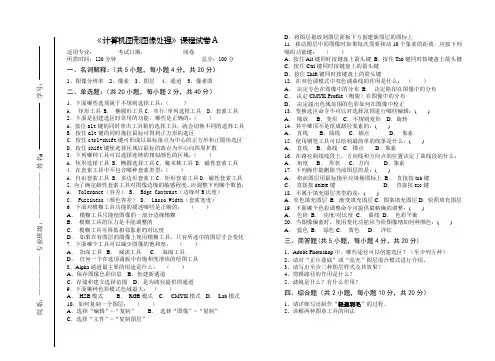
《计算机图形图像处理》课程试卷A适用专业:考试日期:闭卷所需时间:120分钟总分:100分一、名词解释:(共5小题,每小题4分,共20分)1、图像分辨率2、像素3、图层4、通道5、像素图二、单选题:(共20小题,每小题2分,共40分)1.下面哪些选项属于不规则选择工具:()A.矩形工具 B.椭圆形工具C.单行/单列选框工具 D.套索工具2.下面是创建选区时常用的功能,哪些是正确的:()A.按住alt键的同时单击工具箱的选择工具,就会切换不同的选择工具B.按住alt键的同时拖拉鼠标可得到正方形的选区C. 按住ctrl+shift键可形成以鼠标落点为中心的正方形和正圆形选区D.按住shift键使选择区域以鼠标的落点为中心向四周扩散3.下列哪种工具可以选择连续的相似颜色的区域:()A.矩形选择工具 B.椭圆选择工具C.魔术棒工具 D.磁性套索工具4.在套索工具中不包含哪种套索类型:()A.自由套索工具 B.多边形套索工C.矩形套索工具D.磁性套索工具5.为了确定磁性套索工具对图像边缘的敏感程度,应调整下列哪个数值:A. Tolerance(容差) B. Edge Contrast(边缘对B比度)C. Fuzziness(颜色容差) D. Lasso Width(套索宽度)6.下面对模糊工具功能的描述哪些是正确的:()A.模糊工具只能使图像的一部分边缘模糊B.模糊工具的压力是不能调整的C.模糊工具可降低相邻象素的对比度D.如果在有图层的图像上使用模糊工具,只有所选中的图层才会变化7.下面哪个工具可以减少图像的饱和度:()A.加深工具 B.减淡工具C.海绵工具D.任何一个在选项调板中有饱和度滑块的绘图工具8.Alpha通道最主要的用途是什么:()A.保存图像色彩信息B.创建新通道C.存储和建立选择范围D.是为路径提供的通道9.下面哪种色彩模式色域最大:()A.HSB模式B.RGB模式C.CMYK模式D.Lab模式10.如何复制一个图层:()A.选择“编辑”>“复制”B.选择“图像”>“复制”C.选择“文件”>“复制图层”D.将图层拖放到图层面板下方创建新图层的图标上11.移动图层中的图像时如果每次需要移动10个象素的距离,应按下列哪组功能键:()A.按住Alt键同时按键盘上箭头键B.按住Tab键同时按键盘上箭头键C.按住Ctrl键同时按键盘上的箭头键D.按住Shift键同时按键盘上的箭头键12.在双色调模式中双色调曲线的作用是什么:()A.决定专色在图像中的分布B.决定陷印在图像中的分布C.决定CMYK Profile(概貌)在图像中的分布D.决定超出色域范围的色彩如何在图像中校正13.变换选区命令不可以对选择范围进行哪些编辑:( )A.缩放B.变形C.不规则变形D.旋转14.其中哪项不是组成路径要素的:( )A.直线B.曲线C.锚点D.象素15.使用钢笔工具可以绘制最简单的线条是什么:( )A.直线B.曲线C.锚点D.象素16.在路径曲线线段上,方向线和方向点的位置决定了曲线段的什么:A.角度B.形状C.方向D.象素17.下列操作能删除当前图层的是:( )A.将此图层用鼠标拖至垃圾桶图标上B.直接按tab键C.直接按delete键D.直接按esc键18.不属于填充图层类型的是:( )A.单色填充图层B.渐变填充图层C.图案填充图层D.快照填充图层19.下面哪个色彩调整命令可提供最精确的调整:( )A.色阶B.亮度/对比度C.曲线D.色彩平衡20.当图像偏蓝时,使用变化功能应当给图像增加何种颜色:( ) A.蓝色B.绿色C.黄色D.洋红三、简答题(共5小题,每小题4分,共20分)1、Adobe Photoshop中,哪些途径可以创建选区?(至少列五种)2、请对“正片叠底”或“亮光”图层混合模式进行介绍。
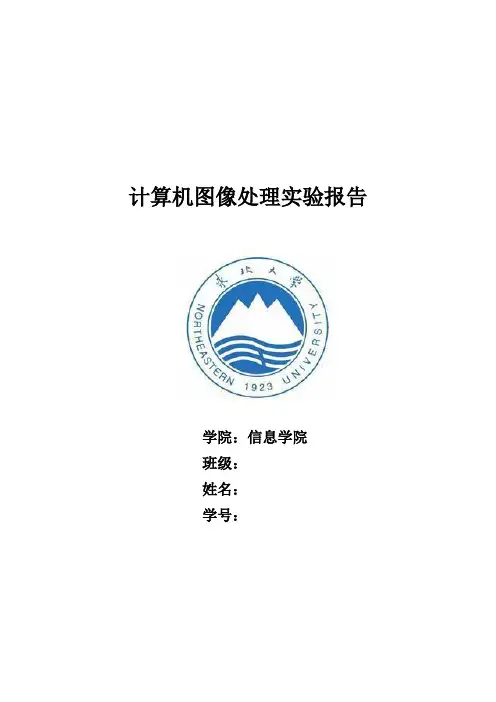
计算机图像处理实验报告学院:信息学院班级:姓名:学号:实验内容:数字图像处理1、应用MATLAB语言编写显示一幅灰度图像、二值图像、索引图像及彩色图像的程序,并进行相互之间的转换;(1)、显示一副真彩RGB图像代码:I=imread('mikasa.jpg');>>imshow(I);效果:(2)、RGB转灰度图像代码:graycat=rgb2gray(I);>> subplot(1,2,1);>> subimage(I);>> subplot(1,2,2);>> subimage(graycat);效果:(3)、RGB转索引图像代码:[indcat,map]=rgb2ind(I,0.7);>> subplot(1,2,1);>> subimage(I);>> subplot(1,2,2);>> subimage(indcat,map);效果:(4)、索引图像转RGB代码:I1=ind2rgb(indcat,map);>>subplot(1,2,1);>>subimage(indcat,map);>>subplot(1,2,2);>>subimage(I1);效果:(5)、索引转灰度图像代码:i2gcat=ind2gray(indcat,map);>>subplot(1,2,1);>>subimage(indcat,map);>>subplot(1,2,2);>>subimage(i2gcat);效果:(6)、灰度转索引图像代码:[g2icat,map]=gray2ind(graycat,64);>>subplot(1,2,1);>>subimage(graycat);>>subimage(g2icat,map);效果:(7)、RGB转二值图像代码:r2bwcat=im2bw(I,0.5);>>subplot(1,2,1);>>subimage(I);>>subplot(1,2,2);>>subimage(r2bwcat);效果:(8)灰度转二值图像代码:g2bwcat=im2bw(graycat,0.5); subplot(1,2,1);>>subimage(graycat);>>subplot(1,2,2);>>subimage(g2bwcat);效果:(9)、索引转二值图像代码:>> i2bwcat=im2bw(indcat,map,0.7);>>subimage(indcat,map);>>subplot(1,2,2);>>subimage(i2bwcat);效果:2、应用MATLAB工具箱演示一幅图像的傅里叶变换、离散余弦变换,观察其频谱图。
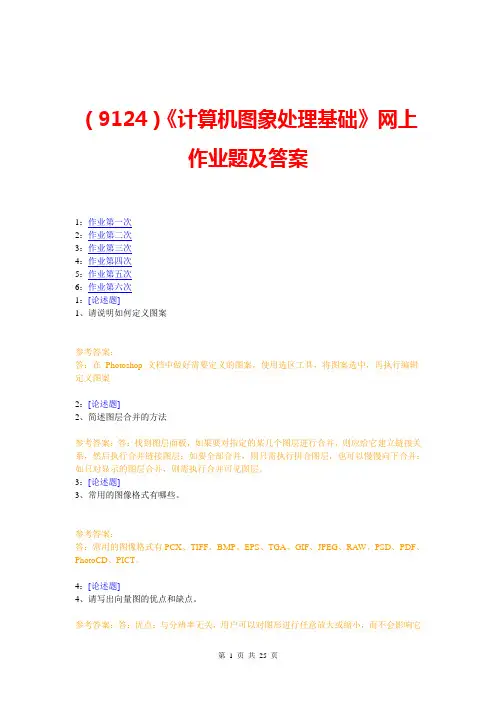
(9124)《计算机图象处理基础》网上作业题及答案1:作业第一次2:作业第二次3:作业第三次4:作业第四次5:作业第五次6:作业第六次1:[论述题]1、请说明如何定义图案参考答案:答:在Photoshop文档中做好需要定义的图案,使用选区工具,将图案选中,再执行编辑-定义图案2:[论述题]2、简述图层合并的方法参考答案:答:找到图层面板,如果要对指定的某几个图层进行合并,则应给它建立链接关系,然后执行合并链接图层;如要全部合并,则只需执行拼合图层,也可以慢慢向下合并;如只对显示的图层合并,则需执行合并可见图层。
3:[论述题]3、常用的图像格式有哪些。
参考答案:答:常用的图像格式有PCX、TIFF、BMP、EPS、TGA、GIF、JPEG、RAW、PSD、PDF、PhotoCD、PICT。
4:[论述题]4、请写出向量图的优点和缺点。
参考答案:答:优点:与分辨率无关,用户可以对图形进行任意放大或缩小,而不会影响它的清晰度和光滑度;便于修改,通过调整其控制点位置,可轻松修改其形状。
5:[论述题]5、写出色域的定义。
参考答案:答:独立。
图像中的每个图层都是独立的,因而当移动、调整或删除某个图层时,其他的图层不受任何影响;透明。
图层可看作是透明的胶片,未绘制图像的区域可看见下方的图层内容。
将众多的图层按一定次序叠加在一起,便可得到复杂的图像;叠加。
图层由上至下叠加在一起,但并不是简单地堆积,通过控制各图层的混合模式和选项,可得到千变万化的图像合成效果。
6:[论述题]6、Photoshop为用户提供了多种选区制作方法,分别是什么?参考答案:答:独立。
图像中的每个图层都是独立的,因而当移动、调整或删除某个图层时,其他的图层不受任何影响;透明。
图层可看作是透明的胶片,未绘制图像的区域可看见下方的图层内容。
将众多的图层按一定次序叠加在一起,便可得到复杂的图像;叠加。
图层由上至下叠加在一起,但并不是简单地堆积,通过控制各图层的混合模式和选项,可得到千变万化的图像合成效果。
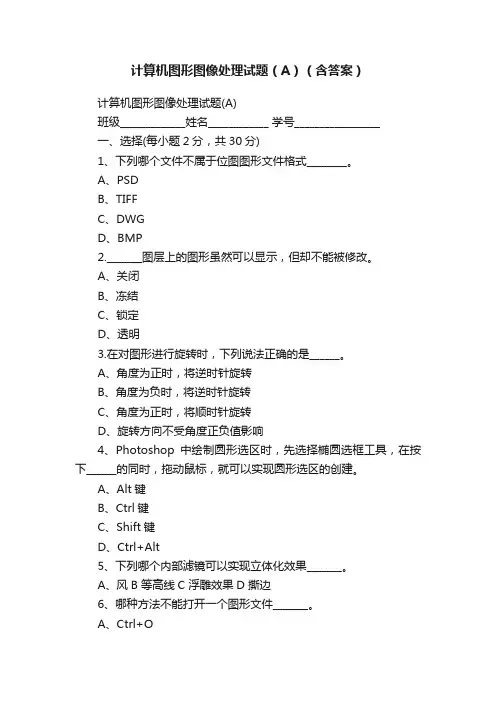
计算机图形图像处理试题(A)(含答案)计算机图形图像处理试题(A)班级_____________姓名____________ 学号_________________一、选择(每小题2分,共30分)1、下列哪个文件不属于位图图形文件格式________。
A、PSDB、TIFFC、DWGD、BMP2._______图层上的图形虽然可以显示,但却不能被修改。
A、关闭B、冻结C、锁定D、透明3.在对图形进行旋转时,下列说法正确的是______。
A、角度为正时,将逆时针旋转B、角度为负时,将逆时针旋转C、角度为正时,将顺时针旋转D、旋转方向不受角度正负值影响4、Photoshop中绘制圆形选区时,先选择椭圆选框工具,在按下______的同时,拖动鼠标,就可以实现圆形选区的创建。
A、Alt键B、Ctrl键C、Shift键D、Ctrl+Alt5、下列哪个内部滤镜可以实现立体化效果_______。
A、风B 等高线C 浮雕效果D 撕边6、哪种方法不能打开一个图形文件_______。
A、Ctrl+OB、双击工作区域C、直接从外部拖动一幅图片到Photoshop界面上D、Ctrl+n7、Photoshop中设置一个适当的羽化值,然后对选区内的图形进行多次Del操作可以实现_______。
A、选区边缘的锐化效果B、选区边缘的模糊效果C、选区扩边D、选区扩大8、Photoshop中在默认情况下使用缩放工具时,按住Alt键的同时点击鼠标左键,可以实现_______。
A、图像像素匹配B、图像大小适合屏幕C、图像缩小D、图像放大9、Photoshop中要同时移动多个图层,则需先对它们进行_______操作。
A、图层链接B、图层格式化C、图层属性设置D、图层锁定10、下列哪个不属于在图层面板中可以调节的参数_______。
A、透明度B、编辑锁定C、显示隐藏当前图层D、图层的大小11、为了确定磁性套索工具对图像边缘的敏感程度,应调整下列哪个数值______。
=================================================================================================== 1:[单选题]下面对矢量图和象素图描述正确的是:A:矢量图的基本组成单元是象素B:象素图的基本组成单元是锚点和路径C:ADOBE ILLUSTRATOR 9图形软件能够生成矢量图D:ADOBE PHOTOSHOP 6 能够生成矢量图参考答案:C2:[单选题]图象分辨率的单位是:A:DPIB:PPIC:LPID:PIXEL参考答案:B3:[单选题]Photoshop的开发公司名称是A:AdobeB:MacromediaC:IBMD:Microsoft参考答案:A4:[单选题]色彩深度是指在一个图象中什么的数量:A:颜色B:饱和度C:亮度D:灰度=================================================================================================== 参考答案:A5:[单选题]图象必须是何种模式,才可以转换为位图模式:A:RGBB:灰度C:多通道D:索引颜色参考答案:B6:[单选题]在双色调模式中双色调曲线的作用是什么:A:决定专色在图象中的分布B:决定陷印在图象中的分布C:决定CMYK PROFILE(概貌)在图象中的分布D:决定超出色域范围的色彩如何在图象中校正参考答案:A7:[单选题]下面哪种色彩模式色域最大:A:HSB模式B:RGB模式C:CMYK模式D:LAB模式参考答案:D8:[单选题]当将CMKY模式的图象转换为多通道时,产生的通道名称是什么:A:青色、洋红和黄色B:四个名称都是ALPHA通道C:四个名称为BLACK(黑色)的通道D:青色、洋红、黄色和黑色===================================================================================================参考答案:D9:[单选题]什么色彩模式的图象转换为多通道模式时,建立的通道名称均为ALPHA:A:RGB模式B:CMYK模式C:LAB模式D:MULTICHANNEL 模式参考答案:C10:[单选题]索引颜色模式的图象包含多少种颜色:A:2B:256C:约65,000D:1670万参考答案:B11:[判断题]色彩深度是指图像中像素的数量参考答案:错误12:[判断题]图像分辨率的单位是dpi参考答案:错误13:[判断题]Photoshop中按Shift+Tab键可以将工具箱和调板全部隐藏显示参考答案:错误14:[判断题]暂存磁盘受Photoshop控制而不受操作系统控制参考答案:正确15:[判断题]Photoshop中只有铅笔工具的选项栏中才有Auto Erase(自动抹掉)选项参考答案:正确16:[判断题]Photoshop中Background Eraser Tool(背景像皮擦工具)不受图层调板上锁定透明的影响,使用完背景像皮擦工具后,原来的背景图像自动转化为普通图层。
大作业指导书题目:数字图像处理院(系):物联网工程学院专业: 计算机班级:计算机1401-1406指导老师:学号:姓名:设计时间: 2016-2017学年 1学期摘要 (3)一、简介 (3)二、斑点数据模型.参数估计与解释 (4)三、水平集框架 (5)1.能量泛函映射 (5)2.水平集传播模型 (6)3.随机评估方法 (7)四、实验结果 (8)五、总结 (11)基于水平集方法和G0模型的SAR图像分割Abstract(摘要)这篇文章提出了一种分割SAR图像的方法,探索利用SAR数据中的统计特性将图像分区域。
我们假设为SAR图像分割分配参数,并与水平集模型相结合。
分布属于G分布中的一种,处于数据建模的目的,它们已经成功的被用于振幅SAR图像中不同区域的建模。
这种统计数据模型是驱动能量泛函执行区域映射的基础,被引用到水平集传播数值方案中,将SAR 图像分为均匀、异构和极其异构区域。
此外,我们引入了一个基于随机距离和模型的评估过程,用于量化我们方法的鲁棒性和准确性。
实验结果表明,我们的算法对合成和真实SAR 数据都具有准确性。
+简介1、Induction(简介)合成孔径雷达系统是一种成像装置,采用相干照明比如激光和超声波,并会受到斑点噪声的影响。
在SAR图像处理过程中,返回的是斑点噪声和雷达切面建模在一起的结果。
这个积性模型(文献[1])因包含大量的真实SAR数据,并且在获取过程中斑点噪声被建模为固有的一部分而被广泛应用。
因此,SAR图像应用区域边界和目标检测变得更加困难,可能需要斑点去除。
因此,斑点去除是必需的,有效的方法可以在文献[2][3][4][5][6][7][8][9][10]中找到。
对于SAR图像分割,水平集方法构成一类基于哈密顿-雅克比公式的重要算法。
水平集方法允许有效的分割标准公式,从文献[12]中讨论的传播函数项可以得到。
经典方法有着昂贵的计算成本,但现在的水平集的实现配置了有趣的低成本的替换。
计算机图形图像处理试题(A)班级_____________姓名____________ 学号_________________一、选择(每小题2分,共30分)1、下列哪个文件不属于位图图形文件格式________。
A、PSDB、TIFFC、DWGD、BMP2._______图层上的图形虽然可以显示,但却不能被修改。
A、关闭B、冻结C、锁定D、透明3.在对图形进行旋转时,下列说法正确的是______。
A、角度为正时,将逆时针旋转B、角度为负时,将逆时针旋转C、角度为正时,将顺时针旋转D、旋转方向不受角度正负值影响4、Photoshop中绘制圆形选区时,先选择椭圆选框工具,在按下______的同时,拖动鼠标,就可以实现圆形选区的创建。
A、Alt键B、Ctrl键C、Shift键D、Ctrl+Alt5、下列哪个内部滤镜可以实现立体化效果_______。
A、风B 等高线C 浮雕效果D 撕边6、哪种方法不能打开一个图形文件_______。
A、Ctrl+OB、双击工作区域C、直接从外部拖动一幅图片到Photoshop界面上D、Ctrl+n7、Photoshop中设置一个适当的羽化值,然后对选区内的图形进行多次Del操作可以实现_______。
A、选区边缘的锐化效果B、选区边缘的模糊效果C、选区扩边D、选区扩大8、Photoshop中在默认情况下使用缩放工具时,按住Alt键的同时点击鼠标左键,可以实现_______。
A、图像像素匹配B、图像大小适合屏幕C、图像缩小D、图像放大9、Photoshop中要同时移动多个图层,则需先对它们进行_______操作。
A、图层链接B、图层格式化C、图层属性设置D、图层锁定10、下列哪个不属于在图层面板中可以调节的参数_______。
A、透明度B、编辑锁定C、显示隐藏当前图层D、图层的大小11、为了确定磁性套索工具对图像边缘的敏感程度,应调整下列哪个数值______。
A、容差B、边缘对比度C、颜色容差D、套索宽度12.如果给定圆心和起点,,下列指定的________不能画出精确的圆弧。
计算机图像处理——图像的概念及整体课程体会学院:xxx班级:xxx姓名:xxx学号:xxxx2011/5/16我们本门课程共讲八章,通过十多周的学习,我学到了关于计算机图像处理的基本知识,对计算机图像处理有了更深一层次的理解。
以下是图像的基本概念及我学习本课程的体会。
图像的基本概念1.1图像数字化图像按表现方式不同分为连续图像和离散图像:连续图像——日常生活中见到的图像一般是连续形式的模拟图像,可由一个二维连续函数f (x ,y )来描述。
其中:(x, y)是图像平面上任意一个二维坐标点, f (x, y)则是该点颜色的深浅。
离散图像—— 用一个数字阵列表示的图像。
阵列中每一个元素称为像素,像素是组成数字图像的基本元素。
数字图像处理的一个先决条件就是将连续图像经采样、量(离散)化,转换为数字图像。
所谓的图像数字化是指将模拟图像经过离散化之后,得到用数字表示的图像。
图像的数字化包括了空间离散化(即采样)明暗表示数据的离散化(即量化)由于图像是一种二维分布的信息,对它进行采样操作也是二维的。
采样示意图采样时的注意点是:采样间隔的选取。
采样间隔太小,则增大数据量;太大,则会发生信息的混叠,导致细节无法辨认。
分辨率 是指映射到图像平面上的单个像素的景物元素的尺寸。
单位:像素/英寸,像素/厘米(如:扫描仪的指标 300dpi)。
分辨率 或者是指要精确测量和再现一定尺寸的图像所必需的像素个数。
单位:像素×像素(如:数码相机指标30万像素 (640×480))。
量化是将各个像素所含的明暗信息离散化后,用数字来表示称为图像的量化;一般的量化值用整数来表示。
充分考虑到人眼的识别能力之后,目前非特殊用途的图像均为8比特(bit)量化,即用0~255描述“黑~白”。
采样行隔采样间隔量化可分为均匀量化和非均匀量化。
均匀量化是简单地在灰度范围内等间隔量化。
非均匀量化是对像素出现频度少的部分量化间隔取大,而对频度大的量化间隔取小。
计算机图像处理——图像的概念及整体课程体会学院:xxx班级:xxx姓名:xxx学号:xxxx2011/5/16我们本门课程共讲八章,通过十多周的学习,我学到了关于计算机图像处理的基本知识,对计算机图像处理有了更深一层次的理解。
以下是图像的基本概念及我学习本课程的体会。
图像的基本概念1.1图像数字化图像按表现方式不同分为连续图像和离散图像:连续图像——日常生活中见到的图像一般是连续形式的模拟图像,可由一个二维连续函数f (x ,y )来描述。
其中:(x, y)是图像平面上任意一个二维坐标点, f (x, y)则是该点颜色的深浅。
离散图像—— 用一个数字阵列表示的图像。
阵列中每一个元素称为像素,像素是组成数字图像的基本元素。
数字图像处理的一个先决条件就是将连续图像经采样、量(离散)化,转换为数字图像。
所谓的图像数字化是指将模拟图像经过离散化之后,得到用数字表示的图像。
图像的数字化包括了空间离散化(即采样)明暗表示数据的离散化(即量化)由于图像是一种二维分布的信息,对它进行采样操作也是二维的。
采样示意图采样时的注意点是:采样间隔的选取。
采样间隔太小,则增大数据量;太大,则会发生信息的混叠,导致细节无法辨认。
分辨率 是指映射到图像平面上的单个像素的景物元素的尺寸。
单位:像素/英寸,像素/厘米(如:扫描仪的指标 300dpi)。
分辨率 或者是指要精确测量和再现一定尺寸的图像所必需的像素个数。
单位:像素×像素(如:数码相机指标30万像素 (640×480))。
量化是将各个像素所含的明暗信息离散化后,用数字来表示称为图像的量化;一般的量化值用整数来表示。
充分考虑到人眼的识别能力之后,目前非特殊用途的图像均为8比特(bit)量化,即用0~255描述“黑~白”。
采样间隔采样间隔量化可分为均匀量化和非均匀量化。
均匀量化是简单地在灰度范围内等间隔量化。
非均匀量化是对像素出现频度少的部分量化间隔取大,而对频度大的量化间隔取小。
一般情况下,对灰度变化比较平缓的部分用比较多的量化级,在灰度变化比较剧烈的地方用比较高的采样密度。
低比特量化的伪轮廓现象图例灰度变换比较平缓的区域(天空)采用较低量化级数,容易产生伪轮廓。
量化的过程也称为A/D转换:是将光电传感器产生的模拟量转换为数字量,以便计算机处理;转换过程:采样、量化、编码;转换精度:ADC位数;转换速度:采样速率;量化误差。
经数字化的图像方可用计算机来处理。
图像f(x ,y)必须在空间上和在颜色深浅的幅度上都进行数字化:空间坐标(x ,y)的数字化被称为图像采样;颜色深浅幅度的数字化被称为灰度级量化。
假定连续图像f(x ,y)被等距离取点采样形成一个N×N方形点阵,它可用下式表示:上式右边就是一个通常所说的数字图像。
其中每一个元素称之为像素。
图像的数字化1.2数字图像的描述矩阵是按照行列的顺序来定位数据的,但是图像是在平面上定位数据的,所以有一个坐标系定义上的特殊性。
为了编程方便起见,这里以矩阵坐标系来定义图像的坐标。
黑白图像是指图像的每个像素只能是黑或者白,没有中间的过渡,故又称为二值图像。
二值图像的像素值为0、1。
灰度图像是指每个像素的信息由一个量化的灰度级来描述的图像,没有彩色信息。
彩色图像是指每个像素的信息由RGB三原色构成的图像,其中RBG是由不同的灰度级来描述的。
1.3图像数字位图文件结构图像是由排成矩形点阵的像素组成的。
图像通常与操作系统有关:windows、unix、mac;图像有不同的编码方式:无压缩、无损压缩、有损压缩。
把一幅图像记录进文件时,必须同时记录下各像素在点阵中的位置及像素的灰度值。
实际上我们可以利用各像素在文件中的记录位置来表示其在图像点阵中的位置,这样就可以省去记录像素位置坐标的数据量,而各像素的数据只用来记录其灰度值。
文件中的数据只能以一维方式记录,而图像点阵是二维的。
为了用一维形式记录二维图像,通常采用的办法是将各行像素的数据首尾相连。
例如,一幅M×N图像的数据文件中,它的M×N个像素数据是这样排列的:最初的N个数据分别对应图像第一行从左到右N个像素;第N+1到第2N个数据分别对应图像第二行从左到右N 个像素,等等。
如此类推,最后的N个数据分别对应图像第M行从左到右N个像素。
这样就必须在文件中某处注明该图像的尺寸,即长度与宽度,以便在读取数据时能够根据这个尺寸重新把一维数据流排列成原来的二维点阵。
图像的尺寸(长与宽,均以像素为单位)通常记录在文件头(header)中。
文件头是有关图像整体的信息数据块,除记录图像的尺寸外,还记录诸如像素的位长、图像的颜色表等有关信息。
文件头之后才是图像的数据流。
因此,图像数据文件是文件头加数据流。
图像数据的文件格式随着图像的各种信息的内容取舍与记录次序的不同而异。
其中,关于图像数据的记录方式基本相同,主要的差异在于header的内容。
应用较广,比较常见的静态图像文件格式有: BMP/DIB、 JPEG、 PNG、Tiff、Gif、RAW、 PCX、PostScript、DXF、HP-GL、WMF。
Bmp是Microsoft Windows设备无关位图(Microsoft Device Independent Bitmap)文件,又称为DIB 。
是Windows操作系统的标准文件格式。
虽然大部分BMP文件是不压缩的形式,它本身还是支持图像压缩的,如rle格式(行程长度编码,runlength encoding)和LZW压缩格式等。
Bmp可以包含每个像素l位、4位、8位或24位的图形。
其中1、4和8位图形有彩色映像(调色板),而24位元图形则是真彩色(TrueColor)。
优点:在Microsoft Windows下得到广泛使用。
缺点:除了Microsoft Windows外,无法在其他环境下使用。
真彩色模式的数据区结构•索引色模式的数据区调色板数据紧接在图像信息之后,用于说明位图的颜色,它有若干个表项,每个表项是一个结构体,确定了一种颜色,每个结构体是由4个域组成:调色板中表项的个数由图像所使用的颜色数决定:若不是真彩色图像,表项的个数与图像使用的颜色数相同,每个表项对应了一种颜色(如00,FF,00,00表示纯绿色);若图像为真彩色,每个像素所占的位数BitsPerPixel=24,则图像数据的每3个字节代表一个像素,这3个字节分别定义了像素颜色中蓝、绿、红的亮度,因而就省去了调色板。
图像数据也叫位图阵列,它记录了图像的每一个像素值,在生成图像文件时,Windows从图像的左下角开始(从左到右,从下到上)逐行扫描图像,将图像的像素值一一记录下来,这些记录像素的字节组成了图像数据(位图阵列)。
一行像素所占位图阵列的字节数,必须是4的倍数,倘若不到4的倍数则必须要用0补足。
对于用到调色板的位图,图像数据就是该像素颜色在调色板中的索引值,对于真彩色图,图像数据就是实际的RGB值。
BMP文件读写:文件是图像的载体,对图像进行处理离不开图像的读写。
在数字图像处理中,灰度直方图是最简单且最有用的工具,可以说,对图像的分析与观察,直到形成一个有效的处理方法,都离不开直方图。
灰度直方图是灰度级的函数,是对图像中灰度级分布的统计。
有两种表示形式。
1)图形表示形式:横坐标表示灰度级,纵坐标表示该灰度值出现的次数(频率)。
2)数组表示形式:数组的下标表示相应的灰度级,数组的元素表示该灰度级下的像素个数。
对于一个有256个灰度级,长度和宽度都为几百个像素的常见的图像来说,当然也可以按上述方法作出它的灰度直方图来,但是通常我们不去作那些密密麻麻的直线段,而是用一条通过所有这些直线段(假定这些直线段存在)的顶端的折线来描述它。
如下图:对于真彩色图像,可以作出三条(红、绿、兰)各有256个灰度级以及一条256级的亮度直方图来,也可以作出一条256级的混合直方图。
如下图:直方图的三个重要性质1)灰度直方图表征了图像的一维信息。
只包含了该图像中不同灰度值的像素出现的频率,而所有的空间信息全部丢失。
2)灰度直方图与图像之间的关系是多对一的映射关系。
一幅图像可唯一确定与它对应的直方图,但不同图像可能有相同直方图。
3)子图直方图之和为整图的直方图。
直方图的用途1)数字化参数:直方图给出了一个简单可见的指示,用来判断一幅图像是否合理的利用了全部被允许的灰度级范围。
一般一幅图应该利用全部或几乎全部可能的灰度级,否则等于增加了量化间隔。
丢失的信息将不能恢复。
2)边界阈值选取:假设某图像的灰度直方图具有二峰性,则表明这个图像的较亮的区域和较暗的区域可以较好地分离,取这一点为阈值点,可以得到好的2值处理的效果。
具有二峰性的灰度直方图利用灰度直方图进行阈值分割体会与思考图像是现代社会人们获取信息的一个主要手段。
人们用各种观测系统以不同的形式和手段获得图像,以拓展其认识的范围。
图像以各种形式出现,可视的、不可视的,抽象的、实际的,计算机可以处理的和不适合计算机处理的。
但究其本质来说,图像主要分为两大类:一类是模拟图像,包括光学图像、照相图像、电视图像等。
它的处理速度快,但精度和灵活性差。
另一类是数字图像。
它是将连续的模拟图像离散化后处理变成为计算机能够辨识的点阵图像。
从数字上看,数字图像就是被量化的二维采样数组。
它是计算机技术发展的产物,具有精度高、处理方便和重复性好等特点。
图像处理就是将图像转化为一个数字矩阵存放在计算机中,并采用一定的算法对其进行处理。
图像处理的基础是数学,最主要任务就是各种算法的设计和实现。
目前,图像处理技术已经在很多方面有着广泛的应用。
如通讯技术、遥感技术、生物医学、工业生产、计算机科学等等。
根据应用领域的不同要求,可以将图像处理技术划分为许多分支,其中比较重要的分支有:①图像数字化:通过采样和量化将模拟图像变成便于计算机处理的数字形式。
③图像的增强和复原:主要目的是增强图像中的有用信息,削弱干扰和噪声,使图像清晰或将转化为更适合分析的形式。
③图像编码:在满足一定的保真条件下,对图像进行编码处理,达到压缩图像信息量,简化图像的目的。
以便于存储和传输。
④图像重建:主要是利用采集的数据来重建出图像。
图像重建的主要算法有代数法、傅立叶反投影法和使用广泛的卷积反投影法等。
⑤模式识别:识别是图像处理的主要目的。
如:指纹鉴别、人脸识别等是模式识别的内容。
当今的模式识别方法通常有三种:统计识别法、句法结构模式识别法和模糊识别法。
⑥计算机图形学:用计算机将实际上不存在的,只是概念上所表示的物体进行图像处理和显现出来。
数字图像处理的优点: 1. 再现性好数字图像处理与模拟图像处理的根本不同在于,它不会因图像的存储、传输或复制等一系列变换操作而导致图像质量的退化。